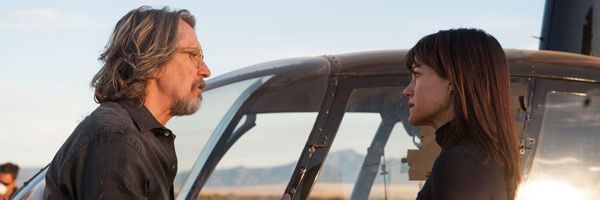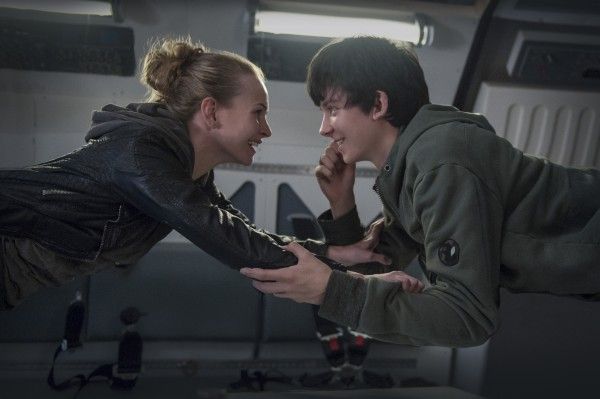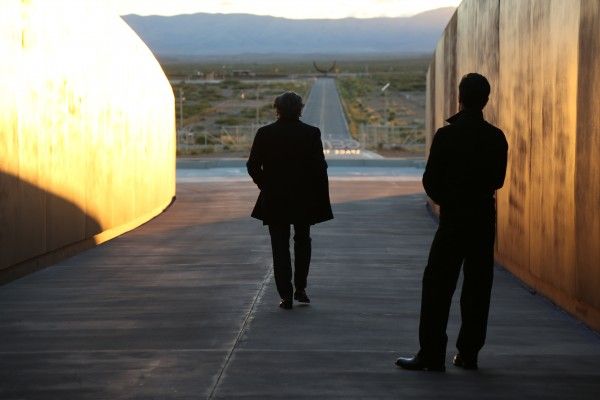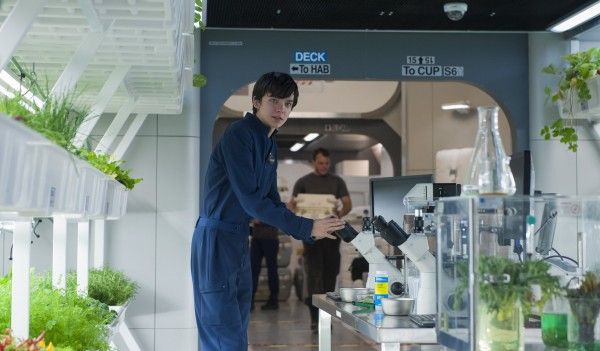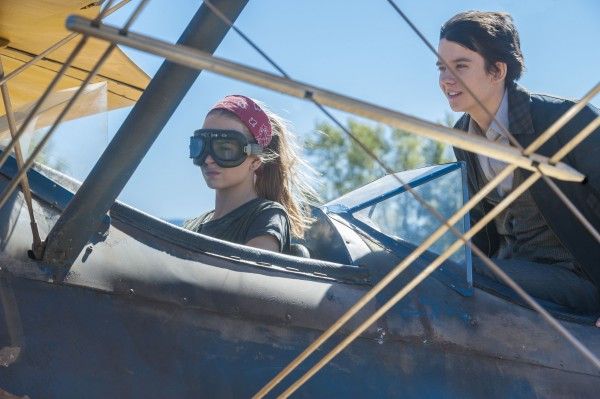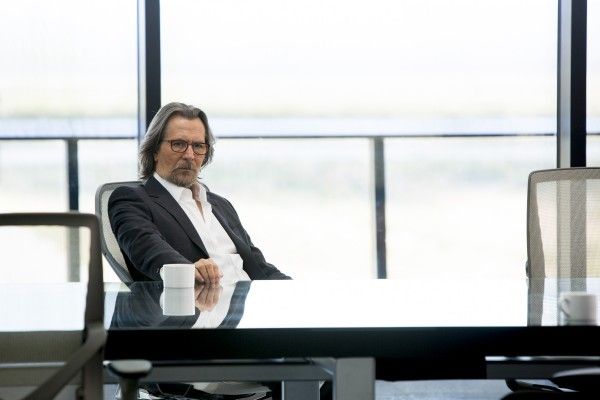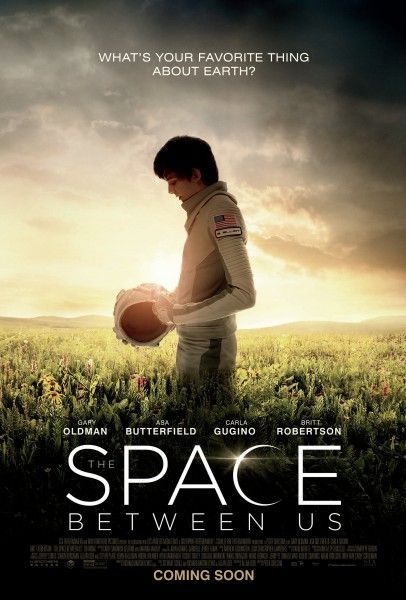Making a movie is not simply the task of an actor, or a director, or a writer. It’s a collaboration between a number of people, all working in service of the story. One of the more unsung heroes on a film’s production is the cinematographer. Not just “the tech person,” a cinematographer is responsible for much more than simply pointing the camera and shooting. He or she works in collaboration with the director, production designer, and actors to figure out how best to visually tell the story at hand. Yes, this also involves lighting the scene and choosing the shot composition, but it’s a highly intricate—and important—job.
Which is why I jumped at the chance to speak with cinematographer Barry Peterson in anticipation of the release of The Space Between Us. The sci-fi film opens in theaters everywhere on February 3rd, and it marks a return to the genre that Peterson explored in films like Jumper before settling into the comedy world. Peterson served as cinematographer on 21 and 22 Jump Street, Sisters, and Zoolander, but he got his start working in the visual effects world, so The Space Between Us brings him full-circle in some ways.
During our conversation we discussed the challenges of making a film with limited gravity, his working relationship with director Peter Chelsom, and what goes into setting up a shot for space-set scenes. But given Peterson’s diverse background, we also discussed how a cinematographer’s role in television differs from film (he shot the pilots for The Good Place and Brooklyn Nine-Nine), the experience of shooting a comedy with a lot of improvisation, his experience working with Doug Liman on Jumper, and a lot more. It was a fun conversation that I hope you’ll find fascinating.
Read the full interview below. The Space Between Us opens in theaters on February 3rd.
So how did you come to be moving from films like Sisters and Central Intelligence to this sci-fi romance genre? How did the project come about for you?
BARRY PETERSON: It’s kind of a funny, very large circle ultimately. I started as a visual effects DP way back, over 24 years ago, and within that I was doing all sorts of different types of things. It was always visual effects based typically, but it started evolving. From that it evolved into music videos, and it evolved into many other things, but my first studio movie ended up being Zoolander, and when you do Zoolander first that’s kind of what people think you do, ultimately. It kind of set that pace for a while. I did step out and do different kinds of films, I worked with Ron Shelton, I did Dark Blue which is an L.A. Riots movie, I worked with Doug Liman on the Jumper movie, which was again stepping out of that genre. I had done a commercial about four and a half years ago with Peter Chelsom, the director of The Space Between Us, and we got along incredibly well. It was a beauty commercial, just fantastic images—we shot in Florida—and he said to me at one point, ‘I would love to work with you on a film one day.’ Out of the blue I got a call, and he said, ‘I’d love you to shoot this movie.’ He wasn’t necessarily looking at what I’d done recently, but he was remembering what we shot in the past and he knew by background.
Was it a little like relearning old tricks in jumping back into the sci-fi realm?
PETERSON: I don’t know whether it’s a misconception or not, but cinematography is as much the telling of the story as it is the technical aspects of it. I think that whether you’re telling a funny story, whether you’re telling a beautiful story, you’re typically reading that script and telling that story. A lot of the tools are similar, but it was nice using different muscles.
What was the biggest challenge for you on this film? I imagine recreating zero-G is tough.
PETERSON: Yep. I think it’s -62% less gravity on Mars, so if you’re 100 pounds you’re gonna weigh 48 pounds or something like that on Mars. We played with that a little bit, but obviously on a movie this size you didn’t want to spend every shot with people in half gravity, so we used it sparingly and we used it at different points to tell the story. But yeah that was definitely a challenge, dealing with cables, then the zero-gravity rigs, the hanging of people—it definitely makes things difficult in terms of camera movement and lighting.
Does that take an extra amount of preparation work? Are the wires pretty predictable or do they sway out of frame?
PETERSON: Yeah I mean we used wires at times, we used low-mounts that people could stand on—it’s almost like standing on a crane. It definitely takes more time. Ultimately you’ve got the technicality of having something overhead, which when you’re shooting you’ve got lights up there, you’ve got sound up there, we definitely had to plan for it and decide how to rig things.
What was your working relationship with Peter like?
PETERSON: Peter is a fantastic man, number one, and what’s interesting is he’s an avid photographer, so he really understands how much you can get with an image; the power of composition, he understands all of that so clearly. So it was a fantastic relationship. He’s a DP’s best friend. And he’s such an actor’s director too, it was interesting to watch him. It was really an interesting experience.
You mentioned Jumper. I know that the Doug Liman experience is a very different kind of experience. What was that like?
PETERSON: Doug is, I’ve said many times—an absolute character would be the best word to say. He’s a genius, he literally does find incredible things, but you do plan on looking left and then you show up on the day and you’re looking right. He’s correct, it’s a better way to look, it looks better to look right and it is better, and he has to see it and he has to feel it on the day and on that moment. So when you’re working with someone like Doug, you’re just prepared to look left or look right.
Were there any particularly memorable moments from shooting that one?
PETERSON: Yeah I think shooting in Rome and getting to shoot at the actual Coliseum was an experience like no other in my life. We were given the keys to the place as of I think 4:00 and I think we had until like 6:00 every day, over five days. But that was an absolute wild experience. We actually got to go down to the catacombs that used to contain the lions and the tigers. Pretty wild experience.
As you said you started on Zoolander and got a little pigeonholed there, but you’ve been doing some excellent work on films like 21 and 22 Jump Street and Sisters, but I was curious, what’s your approach in shooting films with a heavy amount of improv? Are you lighting the entire scene? Is there less of a strict composition and more of giving the actors space to let loose?
PETERSON: Well a movie like Jump Street, we were still trying to design a good-looking movie ultimately, both 21 and 22 Jump Street. We still dealt with composition, but you get somebody like Jonah Hill, you put him in a two-shot, and at some point he’s ultimately gonna start off, he’s gonna start heading off in a new direction and being absolutely crazy. We always shot a two-shot to give them the room to do that, then we typically shoot their close-ups after shot our wide shot or our two-shot so we knew how we had to cover things.
So was it kind of refreshing in a way to come to Space Between Us? Did you guys storyboard on this film?
PETERSON: We storyboarded any of the technical space sequences. Most of it, though—Peter is, again, very much an actor’s director, so I was able to sit and shotlist with Peter and design and watch some of the rehearsals. The rehearsals were very telling, and it was nice to be on a film where I got to sit back and let things breathe a little bit and watch a performance, and have actors moving within a scene and kind of knowing that they were gonna start here and end up there. It was very refreshing.
What’s your approach as a cinematographer film to film? Do you have an overall philosophy that drives you on each film, or is it just attending to each story differently?
PETERSON: Yeah I think that my job is to keep out of the way as much as I personally can. I like to read the script, I like to get the director’s vision, impart my vision, and make it better. I’m not somebody who loves to say, ‘Look I put a big light there!’ and ‘Look how beautiful it looks!’ I want whatever I do to make the story better. If I can keep you in the story and you’re not necessarily noticing the big beautiful shot, but the big beautiful shot’s there, I feel like I’ve done my job.
What would you say is the biggest misconception people have about what a cinematographer does?
PETERSON: I would say the biggest misconception is that we’re just technicians. That we’re all number crunchers and the director’s telling the story and we’re there to just put it on camera. The reality is we’re director partners. We very much take the script with the director and translate it onto screen.
Well you look at a movie like Sisters and the color palate you guys came up with, there was a dynamism to that film. Some comedies can have a tendency to be overlit and, frankly, pretty flat, but your work tends to accentuate color in a way that’s aesthetically interesting. It seems like you’re interested in adding some vibrancy to it.
PETERSON: Absolutely, I do what I can. I’ve fallen into the comedy genre, I’m very happy to be there but I love shooting these other types of films. So I do treat every film, whether it’s a comedy or whether it’s not a comedy, the same. I really try to make them as interesting and as visually driven and story driven as I can. And color’s a big part of that.
Definitely. And speaking of, you also shot the pilots for Brooklyn Nine-Nine and The Good Place, both of which I love. How does a cinematographer’s role in television differ from that of a feature film cinematographer?
PETERSON: Well the biggest thing, ultimately, in television is repetition. On a film you walk in and you’re never doing the same thing twice. As a cinematographer on a feature, typically, you’re reinventing the wheel every time you show up. When you do something like Brooklyn Nine-Nine, once you’ve established a look it should try to keep it consistent.
Is it fun to see the aesthetic that you and Lord and Miller, or you and Drew Goddard, created for these shows continue on after you’ve completed your work on the pilot?
PETERSON: Absolutely. To be honest with you, it’s really interesting because whereas a movie comes and goes quite quickly, some of these shows like Brooklyn Nine-Nine is still playing. I’m still watching it, it’s still on television, so it is interesting to sit back and watch it and know that it was somewhat your baby, the evolution of it or the look of it.
If I’m not mistaken you recently reunited with Ron Shelton for Villa Capri. What was that experience like?
PETERSON: It was absolutely fantastic. Ron Shelton is such a pro, and again he’s another real storyteller, obviously as a writer. So everything ends up being about the characters and the people. It was working with a couple of incredible actors too, you’ve got Morgan Freeman and Tommy Lee Jones. Working with such professional people it was an absolutely great experience.
What kind of aesthetic did you guys hit on for that one?
PETERSON: What it is is a story about Christmas in Palm Springs, in this over-50 community. It was supposed to be the contrast of Christmas in this super warm place, it’s a fish-out-of-water look. It was always quite hot and quite dry, the look. It was interesting.
That cast there is a pretty fantastic.
PETERSON: It was. And again the people were incredible. You’re working with Morgan Freeman and one moment I looked at him and said, ‘I would buy anything from you Morgan no matter what you’re selling.’
I wanna say thank you for taking the time to talk to me today. I’m a big fan of highlighting the kind of work that you guys do.
PETERSON: Absolutely. Hopefully people go see The Space Between Us. I’m really proud of it, it’s a beautiful film. Hopefully other people feel the same way.

